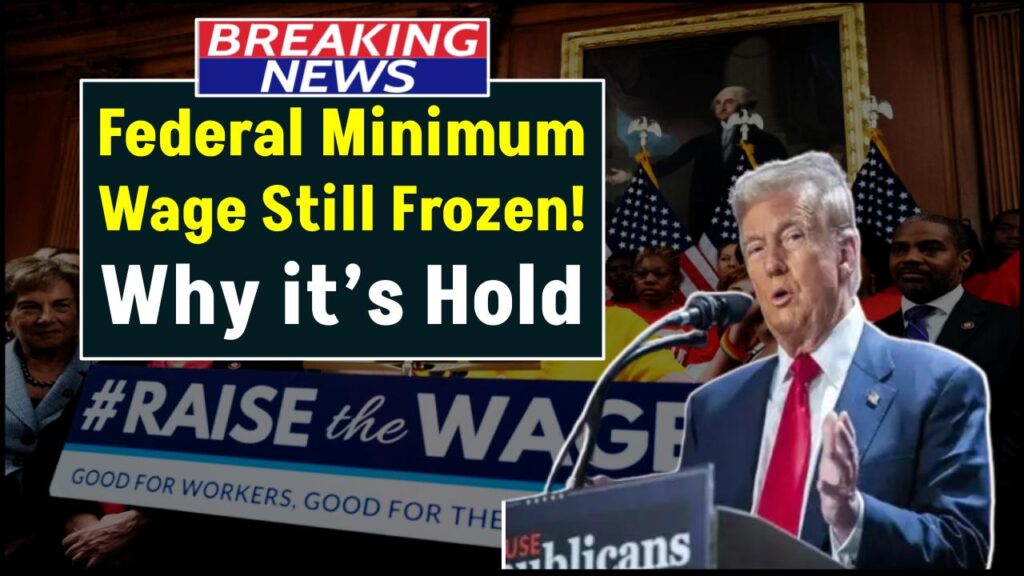Federal Minimum Wage Still Frozen at $7.25—But These States Are Paying Over $15 Right Now
Federal Minimum Wage Still Frozen: As of 2025, the federal minimum wage in the United States remains stuck at $7.25 per hour—a rate that hasn’t changed since 2009. While this wage may have once supported basic living costs, today it barely covers a fast-food meal, let alone rent or utilities.

But here’s the good news: several states and cities have taken matters into their own hands, setting minimum wages well above the federal standard—some even topping $20 per hour. These local laws aim to help workers better cope with the rising cost of living.
Federal Minimum Wage Still Frozen
| Detail | Info |
|---|---|
| Federal Minimum Wage (2025) | $7.25/hour (unchanged since 2009) |
| States with $15+ Minimum Wage | Washington, California, Connecticut, Massachusetts, Maryland, New Jersey, Rhode Island, Illinois, New York |
| Highest Statewide Wage | Washington – $16.66/hour |
| Highest City Minimum Wage | Burien, WA – $21.16/hour for large employers |
| States Scheduled to Hit $15 Soon | Florida, Delaware, Hawaii, Nebraska, Virginia, Alaska, Missouri |
| Source for Official Rates | U.S. Department of Labor |
The federal minimum wage might be stuck at $7.25, but states and cities across the U.S. are stepping up to ensure their workers can earn a living wage. Whether you’re flipping burgers in Seattle or stocking shelves in New York, local laws are making a big difference in how much you take home. To stay informed, know your local wage laws, track policy updates, and use this knowledge to advocate for yourself at work.
What’s Going on With the Federal Minimum Wage?
The federal government hasn’t increased the minimum wage in over 15 years. Back in 2009, $7.25/hour might have made more sense. But fast-forward to today, and that wage buys less than ever due to inflation, rising housing costs, and everyday essentials getting more expensive.
That’s why many states—and even individual cities—have raised their minimum wages to reflect today’s economic reality.
States With Minimum Wages of $15 or More (2025)
These states are leading the charge in wage reform, with hourly rates meeting or exceeding $15:
- Washington – $16.66
- California – $16.00
- Connecticut – $15.69
- New Jersey – $15.49
- New York – $16.50 (NYC, Long Island, Westchester); $15.50 elsewhere
- Massachusetts, Maryland, Rhode Island, Illinois – All at $15.00
These numbers are regularly updated based on cost-of-living data and consumer price indexes. Many of these increases were set in motion years ago as part of gradual wage laws.
Cities Where the Minimum Wage Is Over $20
Some cities go even further—especially in Washington State, where several municipalities now offer some of the highest minimum wages in the nation:
- Burien, WA – $21.16/hour (large employers)
- Tukwila, WA – $21.10/hour (large employers)
- Renton, WA – $20.29/hour (large employers)
- Seattle, WA – $19.97/hour
- SeaTac, WA – $19.71/hour (mainly hospitality and transportation)
These wage increases reflect local efforts to address housing shortages, inflation, and growing income inequality.
States Scheduled to Reach $15/hour in Coming Years
If you live in one of the following states, your paycheck may be getting a boost soon:
- Florida – $15/hour by Sept 30, 2026
- Delaware – $15/hour on Jan 1, 2025
- Hawaii – $16/hour by 2026, then $18 by 2028
- Nebraska & Virginia – $15/hour by 2026
- Alaska & Missouri – Ballot measures passed in 2024 to raise to $15/hour
These increases are often tied to ballot initiatives or state legislation supported by public vote.
Why Do Wages Vary So Much?
The U.S. allows states and cities to set their own minimum wages as long as they’re not below the federal rate. That’s why some areas adapt faster than others. Local economies, cost of living, and politics all play a part.
For example:
- Seattle’s rent and groceries are significantly more expensive than in rural Arkansas—so it makes sense wages there are higher.
- In New York City, employers must pay at least $16.50/hour due to higher living expenses, while other parts of New York are set at $15.50/hour.
What This Means for Workers and Employers
For Workers
- More money in your pocket means greater security
- A higher minimum wage can lead to reduced dependence on public assistance
- Workers in high-cost areas can better afford basics like rent, food, and transportation
For Employers
- Higher wages can boost morale and retention
- May also lead to higher prices or reduced hours if not managed well
- Businesses in high-wage cities are exploring automation, restructuring, or adjusting their service models
Practical Tips for Workers
- Know Your Rights – Check your local wage laws using DOL’s Wage Map
- Track Upcoming Increases – Stay aware of scheduled hikes in your area
- Understand Employer Exceptions – Some small businesses or tipped roles have different rules
- Use Wage Calculators – Estimate how upcoming increases affect your paycheck
Social Security’s Online System Is Changing — Don’t Get Locked Out!
DOGE Dividend Check Could Be Coming — What Taxpayers Must Know!
FAQs on Federal Minimum Wage Still Frozen
Why hasn’t the federal minimum wage changed since 2009?
Congress has not passed legislation to raise it, though attempts have been made. Changes at the federal level often face political gridlock.
Are tipped workers included in these increases?
Not always. Many states have separate minimums for tipped employees. For example, federal law allows $2.13/hour for tipped roles if tips cover the rest.
Can employers pay less than state minimum wages?
Only if the federal rate is lower and there are no state laws. But most state laws override federal rules when they’re higher.
Do youth or training wages apply?
Yes, workers under 20 or those in training may legally earn less during short initial periods—depending on state laws.








